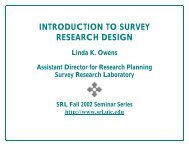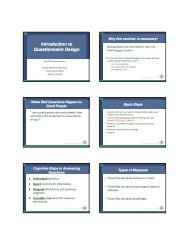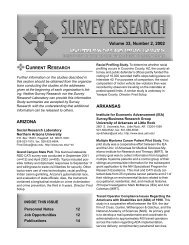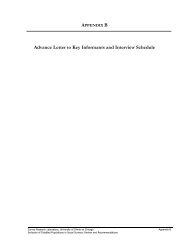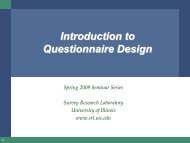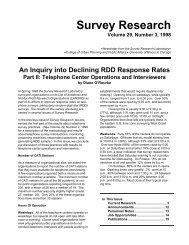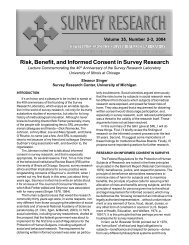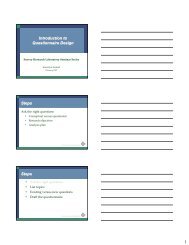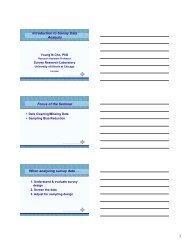Cognitive Processes Syllabus - Survey Research Laboratory
Cognitive Processes Syllabus - Survey Research Laboratory
Cognitive Processes Syllabus - Survey Research Laboratory
You also want an ePaper? Increase the reach of your titles
YUMPU automatically turns print PDFs into web optimized ePapers that Google loves.
Semester: Fall 2003<br />
PA 583: The Psychology of <strong>Survey</strong> Measurement: <strong>Cognitive</strong> and Social <strong>Processes</strong><br />
Instructor: Allyson L. Holbrook<br />
Office Hours: By appointment. Phone: (312)996-0471; E-mail: allyson@uic.edu<br />
Course Credits: 2 hours<br />
Course Overview and Objectives: This course introduces students to one approach to survey<br />
methodology – the examination of the psychological processes through which survey respondents answer<br />
questions. Evidence about these processes from cognitive and social psychology, sociology, and<br />
linguistics is applied to survey research, particularly questionnaire construction and administration.<br />
Required Texts:<br />
Tourangeau, Roger, Lance j. Rips, and Kenneth Rasinski (2000). The Psychology of <strong>Survey</strong><br />
Response. Cambridge, UK: Cambridge University Press.<br />
Schwarz, N. (1996). Cognition and communication: Judgmental biases, research methods, and<br />
the logic of conversation. Hillsdale, NJ: Erlbaum.<br />
Assignments: There are two assignments due during the course. You will also be asked to write<br />
discussion question for three classes and to write a final paper. These assignments are designed for you to<br />
(1) demonstrate your understanding and mastery of the concepts discussed in class; (2) apply these<br />
concepts; and (3) prompt your discussion and questions. (Note: Due dates for assignments are listed in<br />
the course schedule.)<br />
Assignment #1: An article will be distributed for discussion. Students will be asked to write a 2-<br />
3 pages summary and critique of the article. The primary findings of the article or chapter should<br />
be briefly summarized and their implications discussed (1-2 paragraphs). In addition, you should<br />
discuss an issue or problem regarding the major findings of the article. For example, the<br />
conclusions drawn by the author might not be warranted given the evidence they reviewed, or<br />
there might be additional factors the authors did not consider that might be relevant to the<br />
question at hand. Finally, you should briefly discuss additional research that could address the<br />
problem or issue you described. This article (and assignment #1) will the basis for class<br />
discussion.<br />
Assignment #2: Two readings about the use of response latencies to measuring cognitive<br />
processes will be distributed. Students will be asked to write2-3 pages answering the following<br />
questions: 1) What cognitive aspects of question answering might influence response latencies?<br />
2) What are the challenges to using response latencies as an indicator of cognitive processes in<br />
surveys? 3) Briefly describe the methodology and expected results of a study using response<br />
latencies in a novel way to assess the cognitive process of answering survey questions.<br />
Discussion Questions: Students are asked to write discussion questions for 3 of the 7 classes.<br />
These weeks, ple ase write 2-3 discussion questions about the readings for that week and send<br />
them to me at allyson@uic.edu by noon on the day of class. You will be graded on the<br />
promptness and completeness of the questions as well as the quality of the questions themselves.<br />
Final Paper. A final paper is due on the Tuesday of finals week (May 3) by 5:00 p.m. The paper<br />
has two components. First, you should review the literature regarding one aspect of the<br />
psychological processes of answering survey questions and how it relates to survey methodology<br />
1
more broadly. Second, you should outline a proposal for research that builds on the literature<br />
review in Part I. The research you propose should add to our understanding of the psychological<br />
processes of answering survey questions and be tie directly into the aspect of these processes that<br />
you review in Part I of this paper (Each part of the paper should be approximately 10 pages so the<br />
paper should be 20 pages).<br />
Course Policies:<br />
Deadlines: All assignments are due at the beginning of class on the day they are due. Students will<br />
lose 10% credit for each day that an assignment is late. In addition, do the assigned readings before<br />
they are discussed in class.<br />
Extensions for assignments: Extensions for assignments are at the discretion of the instructors and<br />
should be requested before the deadline. Emergencies will be considered on a case-by-case basis. If<br />
you have a question about an extension, please talk to the instructor.<br />
Plagiarism or cheating: Don’t do it. It’s not worth it. Guidelines regarding academic integrity at<br />
UIC are available online , and sanctions for academic<br />
dishonesty are also available . Please don’t put me in a<br />
position where I need to learn more about these policies.<br />
Attendance: Fifteen points will be assigned based on attendance and participation. If you must miss<br />
a class, please let the instructors know in advance. Class attendance is strongly encouraged. Active<br />
involvement in class is also expected. If your final grade is on the border, a subjective assessment of<br />
your class participation may be used to make final adjustments.<br />
Grades<br />
Assignment<br />
Points<br />
Percent of Total<br />
Grade<br />
Assignment #1 20 20<br />
Assignment #2 20 20<br />
Discussion Questions 15 15<br />
Class Participation 10 10<br />
Final Paper 30 30<br />
Attendance 5 5<br />
Total 100 points 100 %<br />
Outline:<br />
March 8 (Week 1)<br />
Part I: <strong>Cognitive</strong> Models of the Response Process<br />
Part II: Pre-testing and measuring cognitive processes<br />
Part III: <strong>Cognitive</strong> interview exercise and discussion<br />
2
March 15 (Week2):<br />
Part I: Comprehension and Interpretation of <strong>Survey</strong> Questions<br />
Part II: Autobiographical Memory<br />
Part III: Discussion Questions (set 1)<br />
Distribute Assignment #1<br />
March 22: NO CLASS - SPRING BREAK<br />
March 29 (Week 3):<br />
Part I: Context Effects in <strong>Survey</strong>s<br />
Part II: <strong>Cognitive</strong> <strong>Processes</strong> and Response Effects (Satisficing)<br />
Part III: Assignment #1 (critique and discussion of article)<br />
Assignment #1 due<br />
April 5 (Week 4)<br />
Part I: Memory Errors in <strong>Survey</strong>s<br />
Part II: Temporal Judgments<br />
Part III: Discussion Questions (set 2)<br />
April 12 (Week 5)<br />
Part I: Estimation <strong>Processes</strong><br />
Part II: Probability Judgments<br />
Part III: Discussion Questions (set 3)<br />
April 19 (Week 6)<br />
Part I: Attitudes<br />
Part II: Persuasion, Social Influence, and Nonresponse<br />
Part III: Mapping, Social Norms and Social Desirability<br />
Distribute Assignment #2<br />
April 26 (Week 7)<br />
Part I: Interviewers: Rapport and Social Distance<br />
Part II: Implications and Summing up<br />
Part III: Assignment #2 Discussion<br />
Assignment #2 due<br />
May 3: Final paper due by 5:00 p.m.<br />
******************************************************************************<br />
3
Schedule and Reading Assignments<br />
Week 1<br />
Part I: <strong>Cognitive</strong> Models of the Response Process<br />
Readings:<br />
Chapter 1 of Tourangeau, R., Rips, L. J., & Rasinksi, K. (2000). The Psychology of<br />
<strong>Survey</strong> Response.<br />
Part II: Pre-testing<br />
Week2:<br />
Readings: To be distributed<br />
Part I: Comprehension and Interpretation of <strong>Survey</strong> Questions<br />
Readings:<br />
Chapter 2 of Tourangeau et al. (2000)<br />
Fowler, F. (1992). How unclear terms affect survey data. Public Opinion Quarterly, 56,<br />
218-231.<br />
Schwarz, N. (1996). Cognition and communication: Judgmental biases, research<br />
methods, and the logic of conversation. Hillsdale, NJ: Erlbaum.<br />
Part II: Autobiographical Memory<br />
Readings<br />
Chapter 3 of Tourangeau et al. (2000)<br />
Shum, M. S., & Rips, L. J. (1999). The Respondent’s Confession: Autobiographical<br />
Memory in the context of <strong>Survey</strong>s. In Sirken, M. G., Herrmann, D. J., Schechter, S.,<br />
Schwarz, N., Tanur, J. M., & Tourangeau, R. (Eds.), Cognition and <strong>Survey</strong> <strong>Research</strong>.<br />
New York: Wiley.<br />
Part III: Discussion Questions (set 1)<br />
4
Week 3:<br />
Week 4<br />
Part I: Context Effects in <strong>Survey</strong>s<br />
Readings<br />
Chapter 7 of Tourangeau et al.<br />
Bishop, G., Oldendick, R., & Tuchfarber, A. (1984). What must my interest in politics be if<br />
I just told you "I don't know"? Public Opinion Quarterly, 48, 510-519.<br />
Schwarz, N., Strack, F., & H. Mai. (1991). Assimilation and contrast effects in part-whole<br />
question sequences: A conversational logic analysis. Public Opinion Quarterly, 55, 3-23.<br />
Part II: <strong>Cognitive</strong> <strong>Processes</strong> and Response Effects<br />
Readings<br />
Krosnick, J. A. (1991). Response strategies for coping with the cognitive demands of<br />
attitude measures in surveys. Applied <strong>Cognitive</strong> Psychology, 5, 213-236.<br />
Krosnick, J., & Alwin, D. (1987). An evaluation of a cognitive theory of response order<br />
effects in survey measurement. Public Opinion Quarterly, 51, 201-219.<br />
Krosnick, J. A., Narayan, S., & Smith, W. R. (1996). Satisficing in <strong>Survey</strong>s: Initial<br />
Evidence. New Directions for Evaluation, 70, 29-44.<br />
Part III: Assignment #1 (critique and discussion of article)<br />
Part I: Memory Errors in <strong>Survey</strong>s<br />
Readings<br />
Loftus, E. F., Smith, K. D., Klinger, M. R. & Fiedler, J. (1992). Memory and mismemory<br />
for health events. In J. M. Tanur (ed), Questions about questions: inquiries into the<br />
cognitive bases of surveys (pp. 102-137). New York: Sage.<br />
Belli, R. F., Traugott, M. W., Young, M., & McGonagle, K. A. (1999). Reducing<br />
Vote Overreporting in <strong>Survey</strong>s: Social Desirability, Memory Failure, and Source<br />
Monitoring. Public Opinion Quarterly, 63, 90-108.<br />
Part II: Temporal Judgments<br />
Readings<br />
Required<br />
Chapters 4 and 5 in Tourangeau, et al. (2000)<br />
Part III: Discussion Questions (set 2)<br />
5
Week 5<br />
Part I: Estimation <strong>Processes</strong><br />
Readings<br />
Required<br />
Schaeffer, N.C., & Bradburn, N. (1989). Respondent behavior in magnitude<br />
estimation. Journal of the American Statistical Association, 84, 402-413.<br />
Burton, S., & Blair, E. (1991). Task conditions, response formulation processes, and<br />
response accuracy for behavioral frequency questions in surveys. Public Opinion<br />
Quarterly, 55, 50-79.<br />
Part II: Probability Judgments<br />
Week 6:<br />
Readings<br />
Part II: Attitudes<br />
Readings<br />
Tversky, A., & Kahneman, D. (1974). Judgment under uncertainty: Heuristics and<br />
biases. Science, 185, 1124-1131.<br />
Hastie, R. & Park, B. (1986). The relationship between memory and judgment depends<br />
on whether the judgment is memory-based or on-line. Psychological Review, 93, 258-<br />
268.<br />
Chapter 6 of Tourangeau et al. (2000)<br />
Dawes, R., & Smith, T. (1985). Attitude and opinion measurement. In G. Lindzey & E.<br />
Aronson (Eds.), The Handbook of Social Psychology: Vol. 1. (3rd ed.). New York:<br />
Random House, pp. 509-566.<br />
Cunningham, W. A., Preacher, K. J., Banaji, M. R. (2001). Implicit attitude<br />
measures: Consistency, stability, and convergent validity. Psychological Science, 121,<br />
163-170.<br />
Fazio, R., Sanbonmatsu, D., Powell, M., & Kardes, F. (1986). On the automatic<br />
activation of attitudes. Journal of Personality and Social Psychology, 37, 229-238.<br />
Part II: Persuasion, Social Influence, and Nonresponse<br />
Readings<br />
Required<br />
Groves, R., Cialdini, R., & Couper, M. (1992). Understanding the decision to<br />
participate in a survey. Public Opinion Quarterly, 56, 475-495.<br />
6
Petty, R. E., Wheeler, S. C., & Tormala, Z. L. (2002). Persuasion and Attitude<br />
Change. In T. Millong & M. J. Lerner (Eds.), Comprehensive handbook of<br />
psychology. New York: John Wiley and Sons.<br />
Part III: Mapping, Social Norms and Social Desirability<br />
Week 7:<br />
Readings<br />
Required<br />
Chapters 8 and 9 of Tourangeau, R., Rips, L. J., & Rasinksi, K. (2000). The<br />
Psychology of <strong>Survey</strong> Response.<br />
Paulhus, D. L. (1984). Two-component models of socially desirable responding.<br />
Journal of Personality & Social Psychology, 46, 598-609.<br />
Bishop, G., Oldendick, R., & Tuchfarber, A. (1986). Opinions on fictitious issues: The<br />
pressure to answer survey questions. Public Opinion Quarterly, 50, 240-250.<br />
Part I: Interviewers: Rapport and Social Distance<br />
Readings<br />
Required<br />
Chapter 10 of Tourangeau et al. (2000)<br />
Schaeffer, N. (1991). Conversation with a purpose--or conversation? Interaction in the<br />
standardized interview. In P. P. Biemer, R. M. Groves, L. E. Lyberg, N. A. Mathiowetz<br />
& S. Sudman (eds), Measurement errors in surveys. New York: Wiley, pp. 367-391.<br />
van der Zouwen, J., Dijkstra, W., & Smit, J. (1991). Studying respondent interviewer<br />
interaction: The relationship between interviewing style, interviewer behavior, and<br />
response behavior. P. P. Biemer, R. M. Groves, L. E. Lyberg, N. A. Mathiowetz & S.<br />
Sudman (eds), Measurement errors in surveys. New York: Wiley, pp. 419-437.<br />
Schober, M. F. (1999). Making sense of questions: An interactional approach. In<br />
Sirken, M. G., Herrmann, D. J., Schechter, S., Schwarz, N., Tanur, J. M., &<br />
Tourangeau, R. (Eds.), Cognition and <strong>Survey</strong> <strong>Research</strong>. New York: Wiley.<br />
Katz, D. (1942). Do interviewers bias poll results? Public Opinion Quarterly, 6, 248-<br />
268.<br />
Part II: Implications and Summing up<br />
Reading (required)<br />
Chapter 11 of Tourangeau et al. (2000).<br />
Part III: Assignment #2 Discussion<br />
7
Optional readings:<br />
<strong>Cognitive</strong> Models of the Response Process<br />
Chapters 1-3 in Sudman, S., Bradburn, N., & Schwarz, N. (1996), Thinking about Answers: The<br />
Application of <strong>Cognitive</strong> <strong>Processes</strong> to <strong>Survey</strong> Methodology. San Francisco: Jossey-Bass.<br />
Bradburn, N., & Danis, C. (1984). Potential contributions of cognitive research to survey<br />
questionnaire design. In T. Jabine et al. (Eds.), <strong>Cognitive</strong> Aspects of <strong>Survey</strong> Design: Building a<br />
Bridge Between Disciplines. Washington: National Academy Press, pp. 101-129.<br />
Strack, F., & Martin, L. (1987). Thinking, judging, and communicating: A process account of context<br />
effects in attitude surveys. In H. Hippler, N. Schwarz, & S. Sudman (Eds.), Social information<br />
processing and survey methodology (pp. 123-148). New York: Springer-Verlag.<br />
Tourangeau, R. (1984). <strong>Cognitive</strong> science and survey methods. In T. Jabine et al. (Eds.), <strong>Cognitive</strong><br />
Aspects of <strong>Survey</strong> Design: Building a Bridge Between Disciplines. Washington: National Academy<br />
Press, pp.73-100.<br />
Chapter 9 of Groves, R. (1989). <strong>Survey</strong> Costs and <strong>Survey</strong> Errors. New York: Wiley.<br />
Comprehension and Interpretation of <strong>Survey</strong> Questions<br />
Bradburn, N., & Miles, C. (1979). Vague quantifiers. Public Opinion Quarterly, 43, 92-101.<br />
Clark, H. (1985). Language use and language users. In G. Lindzey & E. Aronson (Eds.), The<br />
Handbook of Social Psychology: Vol. 2. Special fields and applications (3rd ed.). New York:<br />
Random House, pp. 179-231.<br />
Chase, C. (1969). Often is where you find it. American Psychologist, 24, 1043.<br />
Pace, C., & Friedlander, J. (1982). The meaning of response categories: How often is 'Occasionally,'<br />
'Often,' and 'Very Often'? <strong>Research</strong> in Higher Education, 17, 267-281.<br />
Pepper, S., & Prytulak, L. (1974). Sometimes frequently means seldom: Context effects in the<br />
interpretation of quantitative expressions. Journal of <strong>Research</strong> in Personality, 8, 95-101.<br />
Schaeffer, N. C. (1991). Hardly or constantly? Group comparisons using vague quantifiers. Public<br />
Opinion Quarterly, 55, 395-423.<br />
Wallsten, T., Budescu, D., Rapoport, A., Zwick, R., & Forsythe, B. (1986). "Measuring the vague<br />
meaning of probability terms. Journal of Experimental Psychology: General, 115, 348-365.<br />
Grice, H. (1975). Logic and conversation. In P. Cole & T. Morgan (Eds.), Syntax and Semantics: Vol.<br />
3 Speech Acts (pp. 41-58). New York: Seminar Press.<br />
Context Effects in <strong>Survey</strong>s<br />
Tourangeau, R. (1999). Context effects on answers to attitude questions. In Sirken, M. G.,<br />
Herrmann, D. J., Schechter, S., Schwarz, N., Tanur, J. M., & Tourangeau, R. (Eds.), Cognition and<br />
<strong>Survey</strong> <strong>Research</strong>. New York: Wiley.<br />
8
Chapters 4 and 5 in Sudman, S., Bradburn, N., & Schwarz, N. (1996), Thinking about Answers: The<br />
Application of <strong>Cognitive</strong> <strong>Processes</strong> to <strong>Survey</strong> Methodology. San Francisco: Jossey-Bass.<br />
Tourangeau, R., & Rasinski, K. (1988). "<strong>Cognitive</strong> processes underlying context effects in attitude<br />
measurement." Psychological Bulletin, 103, 229-314.<br />
Schuman, H. (1992). Context effects: State of the art/state of the past. In N. Schwarz & S. Sudman<br />
(Eds.), Context effects in social and psychological research. New York: Springer-Verlag, pp. 35-47.<br />
Tourangeau, R. (1992). "Context effects on attitude responses: The role of retrieval and memory<br />
structures." In N. Schwarz & S. Sudman (Eds.), Context effects in social and psychological research.<br />
New York: Springer-Verlag, pp. 35-47.<br />
Tourangeau, R., Rasinski, K., Bradburn, N., & D'Andrade, R. (1989a). Carryover effects in attitude<br />
surveys. Public Opinion Quarterly, 53, 495-524.<br />
Bishop, G., Oldendick, R., & Tuchfarber, A. (1982). Political information processing: Question order<br />
and context effects. Political Behavior, 4, 177-200.<br />
Bishop, G., Oldendick, R., & Tuchfarber, A. (1984a). Interest in political campaigns: The influence of<br />
question order and electoral context. Political Behavior, 6, 159-168.<br />
McClendon, M., & O'Brien, D. (1988). Question-order effects on subjective well-being. Public<br />
Opinion Quarterly, 52, 351-364.<br />
Smith, T. W. (1991). Context effects in the General Social <strong>Survey</strong>. In P. P. Biemer, R. M. Groves,<br />
L. E. Lyberg, N. A. Mathiowetz & S. Sudman (eds), Measurement errors in surveys. New York:<br />
Wiley, pp. 367-391.<br />
<strong>Cognitive</strong> <strong>Processes</strong> and Response Effects<br />
Chapter 6 in Sudman, S., Bradburn, N., & Schwarz, N. (1996), Thinking about Answers: The<br />
Application of <strong>Cognitive</strong> <strong>Processes</strong> to <strong>Survey</strong> Methodology. San Francisco: Jossey-Bass.<br />
Schwarz, N., & Hippler, H. (1987). What response scales may tell your respondents: Informative<br />
functions of response alternatives. In H. Hippler, N. Schwarz, & S. Sudman (Eds.), Social<br />
Information Processing and <strong>Survey</strong> Methodology. New York: Springer-Verlag.<br />
Wanke, M., Schwarz, N., & Noelle-Neumann, E. (1995). Asking comparative questions: The impact<br />
of the direction of comparison. Public Opinion Quarterly, 59, 347-372.<br />
Bishop, G., Oldendick, R., & Tuchfarber, A. (1983). Effects of filter questions in public opinion<br />
surveys. Public Opinion Quarterly, 47, 528-546.<br />
Autobiographical Memory<br />
Loftus, E. F., & Fathi, D. C. (1985). Retrieving multiple autobiographical memories. Social<br />
Cognition, 3, 280-295.<br />
Wagenaar, W. (1986). My memory: A study of autobiographical memory over six years. <strong>Cognitive</strong><br />
Psychology, 18, 225-252.<br />
Robinson, J. (1986). Temporal reference systems and autobiographical memory. In D. Rubin (Ed.),<br />
Autobiograpical memory. Cambridge: Cambridge University Press, pp. 159-188.<br />
9
Mathiowetz, N. A. (1988). Forgetting events in autobiographical memory: findings from a health care<br />
survey. Proceedings of the Section on <strong>Survey</strong> Methods <strong>Research</strong>, American Statistical Association,<br />
pp. 167-172.<br />
Temporal Judgments<br />
Chapter 8 in Sudman, S., Bradburn, N., & Schwarz, N. (1996), Thinking about Answers: The<br />
Application of <strong>Cognitive</strong> <strong>Processes</strong> to <strong>Survey</strong> Methodology. San Francisco: Jossey-Bass.<br />
Friedman, W. (1993). Memory for the time of past events. Psychological Bulletin, 113, 44-66.<br />
Thompson, C. P., Skowronski, J. J. & Lee, D. J. (1988). Telescoping in dating naturally occurring<br />
events. Memory and Cognition, 16, 461-468.<br />
Loftus, E. F. & Marburger, W. (1983). Since the eruption of Mt. St. Helens, has anyone beaten you<br />
up? Improving the accuracy of retrospective reports with landmark events. Memory and Cognition,<br />
11, 114-120.<br />
Huttenlocher, J., Hedges, L., & Prohaska, V. (1988). Hierarchical organization in ordered domains:<br />
estimating the dates of events. Psychological Review, 95, 471-484.<br />
Sudman, S. & Bradburn, N. M. (1973). Effects of time and memory factors on response in surveys.<br />
Journal of the American Statistical Association, 68, 805-815.<br />
Baddeley, A. D., Lewis, V. & Nimmo-Smith, I. (1978). When did you last ... ? In M. M. Gruneberg &<br />
R. N. Sykes (eds), Practical aspects of memory (pp. 77-83). San Diego, CA: Academic Press.<br />
Rubin, D.C. & Baddeley, A.D. (1989). Telescoping is not time compression: a model of the dating of<br />
autobiographical events. Memory and Cognition, 17, 653-661.<br />
10
Estimation <strong>Processes</strong><br />
Chapter 9 in Sudman, S., Bradburn, N., & Schwarz, N. (1996), Thinking about Answers: The<br />
Application of <strong>Cognitive</strong> <strong>Processes</strong> to <strong>Survey</strong> Methodology. San Francisco: Jossey-Bass.<br />
Huttenlocher, J., Hedges, L., & Bradburn, N. M. (1990). Reports of elapsed time: bounding and<br />
rounding processes in estimation. Journal of Experimental Psychology: Learning, Memory, and<br />
Cognition, 16, 196-213.<br />
Memory Errors in <strong>Survey</strong>s<br />
Chapter 10 in Sudman, S., Bradburn, N., & Schwarz, N. (1996), Thinking about Answers: The<br />
Application of <strong>Cognitive</strong> <strong>Processes</strong> to <strong>Survey</strong> Methodology. San Francisco: Jossey-Bass.<br />
Kolers, P. A., & Palef, S. R. (1976). Knowing not. Memory and Cognition, 4, 553-558.<br />
Neter, J., & Waksberg, J. (1964). A study of response errors in expenditures data from household<br />
interviews. Journal of the American Statistical Association, 59, 17-55.<br />
Jobe, J., Tourangeau, R., & Smith, A.F. (1993). "Contributions of survey research to the<br />
understanding of memory." Applied <strong>Cognitive</strong> Psychology, 7, 567-584.<br />
Blair, J., Menon, G., & Bickart, B. (1991). Measurement effects in self vs. proxy responses: An<br />
information-processing perspective. In P. P. Biemer, R. M. Groves, L. E. Lyberg, N. A. Mathiowetz<br />
& S. Sudman (eds), Measurement errors in surveys (pp. 145-166). New York: Wiley.<br />
Cash, W. S. & Moss, A. J. (1972). Optimum recall period for reporting persons injured in motor<br />
vehicle accidents. Vital and Health Statistics, Series 2, No. 50 (DHEW Publication No. HSM 72-<br />
1050). Washington, DC: U.S. Government Printing Office.<br />
Loftus, E. F., Klinger, M. R., Smith, K. D. & Fiedler, J. (1990). A tale of two questions: benefits of<br />
asking more than one question. Public Opinion Quarterly, 54, 330-345.<br />
Means, B. & Loftus, E. F. (1991). When personal history repeats itself: decomposing memories for<br />
recurring events. Applied <strong>Cognitive</strong> Psychology, 5, 297-318.<br />
Means, B., Swan, G. E., Jobe, J., & Esposito, J. L. (1993). Estimating frequencies for habitual<br />
behaviors: reports of cigarette smoking. In N. Schwarz & S. Sudman (eds), Autobiographical memory<br />
and the validity of retrospective reports. New York: Springer-Verlag.<br />
Means, B., Swan, G. E., Jobe, J. B. & Esposito, J. L. (1991). An alternative approach to obtaining<br />
personal history data. In P. P. Biemer, R. M. Groves, L. E. Lyberg, N. A. Mathiowetz & S. Sudman<br />
(eds), Measurement errors in surveys (pp. 167-183). New York: Wiley.<br />
Menon, G. (1993). Judgments of behavioral frequencies: memory search and retrieval strategies. In<br />
N. Schwarz & S. Sudman (eds), Autobiographical memory and the validity of retrospective reports.<br />
New York: Springer-Verlag.<br />
Mingay, D. J. & Greenwell, M. T. (1989). Memory bias and response-order effects. Journal of<br />
Official Statistics, 5, 253-263.<br />
Smith, A. F. & Jobe, J. B. (1993). Reports of long-term dietary memories: data and a model. In N.<br />
Schwarz & S. Sudman (eds), Autobiographical memory and the validity of retrospective reports. New<br />
York: Springer-Verlag.<br />
11
Smith, A. F., Jobe, J. B. & Mingay, D. J. (1991). Question-induced cognitive biases in reports of<br />
dietary intake by college men and women. Health Psychology, 10, 244-251.<br />
Sudman, S., Finn, A. & Lannom, L. (1984). The use of bounded recall procedures in single<br />
interviews. Public Opinion Quarterly, 48, 520-524.<br />
Tourangeau, R. & Rasinski, K. A. (1987). Evaluation of data collection frequency and the use of a<br />
summary in the National Medical Care Utilization and Expenditure <strong>Survey</strong>. National Medical Care<br />
Utilization and Expenditure <strong>Survey</strong>, Series A, No. 2 (DHHS Publication No. PHS 87-20002).<br />
Washington, DC: U.S. Government Printing Office.<br />
Glucksberg, S. & McCloskey, M. (1981). Decisions about ignorance: knowing what you don't know.<br />
Journal of Experimental Psychology: Human Learning and Memory, 7, 311-325.<br />
Probability Judgments<br />
Gentner, D., & Collins, A. (1981). Studies of inference from lack of knowledge. Memory and<br />
Cognition, 9, 434-443.<br />
Kahneman, D., Slovic, P., & Tversky, A. (1982). Judgment under uncertainty: Heuristics and biases.<br />
Cambridge: Cambridge University Press.<br />
Nisbett, R., & Ross, L. (1980). Human inference: Strategies and shortcomings of social judgment.<br />
Englewood Cliffs, N.J.: Prentice-Hall.<br />
Sherman, S., & Corty, E. (1984). <strong>Cognitive</strong> heuristics. In R. Wyer and T. Srull (Eds.), Handbook of<br />
Social Cognition (pp. 189-286). Hillsdale, NJ: Lawrence Erlbaum.<br />
Attitudes<br />
Salancik, G., & Conway, M. (1975). Attitude inferences from salient and relevant cognitive content<br />
about behavior. Journal of Personality and Social Psychology, 32, 829-840.<br />
Schuman, J., & Presser, S. (1981). Questions and answers in attitude surveys: Experiments in<br />
question form, wording, and context. New York: Academic Press.<br />
12
Persuasion, Social Influence, and Nonresponse<br />
Chaiken, S. (1980). Heuristic versus systematic information processing and the use of source versus<br />
message cues in persuasion. Journal of Personality and Social Psychology, 39, 752-766.<br />
McGuire, W. (1968). The nature of attitudes and attitude change. In G. Lindzey & E. Aronson (Eds.),<br />
The handbook of social psychology, (Vol. 3). Reading, Mass: Addison-Wesley.<br />
Mapping, Social Norms and Social Desirability<br />
DeMaio, Theresa J., "Social Desirability and <strong>Survey</strong> Measurement: A Review," Chapter Nine, pp.<br />
257-282 in Charles F. Turner and Elizabeth Martin, <strong>Survey</strong>ing Subjective Phenomena, Vol. 2, Russell<br />
Sage, 1985.<br />
Interviewers: Rapport and Social Distance<br />
Suchman, L., & Jordan, B. (1990). Interactional troubles in face-to-face survey interviews. Journal of<br />
the American Statistical Association, 85, 232-241.<br />
Fowler, F., & Mangione, T. (1985). The value of interviewer training and supervision. Final Report to<br />
the National Center for Health Services <strong>Research</strong>.<br />
Fowler, F., & Mangione, T. (1989). Standardized survey interviewing: Minimizing interviewerrelated<br />
error. Newbury Park, California: Sage.<br />
Horvitz, D. (1952). Sampling and field procedures in the Pittsburgh Morbidity <strong>Survey</strong>, Public Health<br />
Reports, 67, 1003-1012.<br />
Hyman, H., Cobb, W., Feldman, J., Hart, C., & Stember, C. (1954). Interviewing in social research.<br />
Chicago: University of Chicago Press.<br />
13



